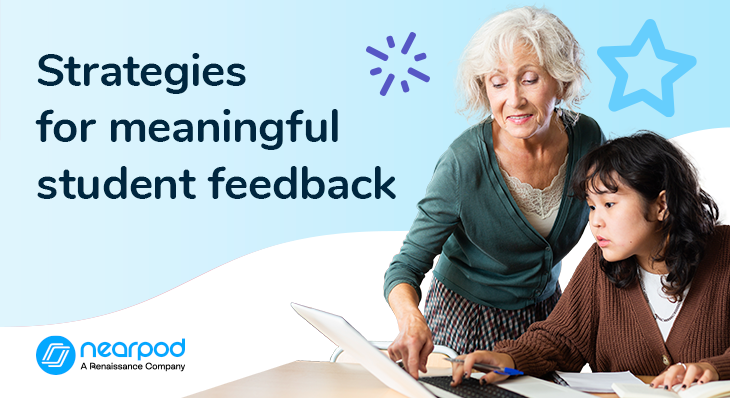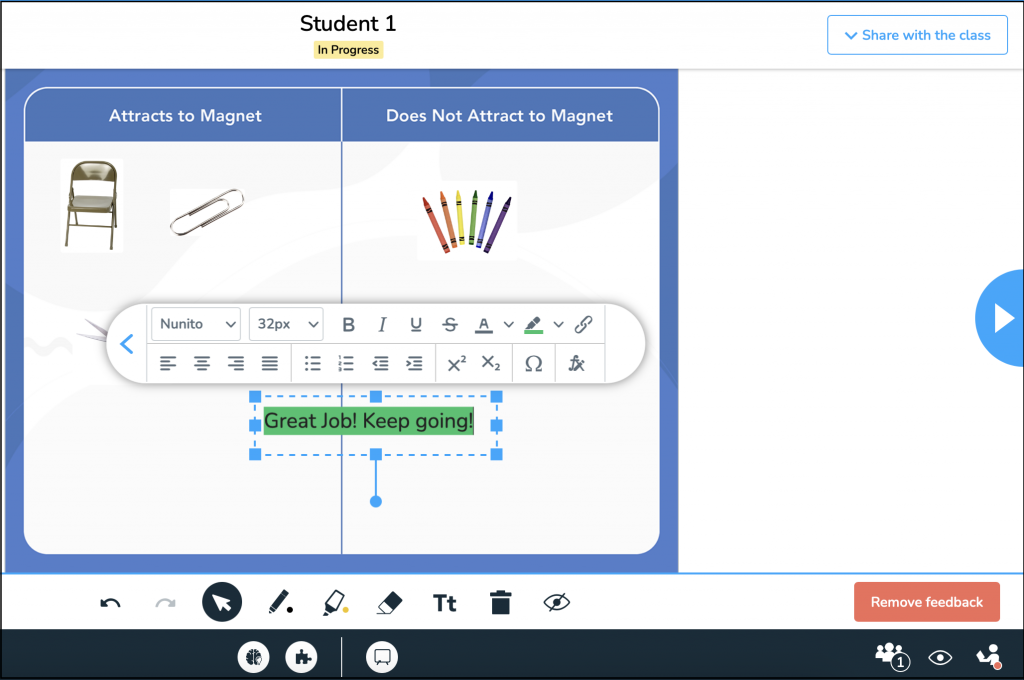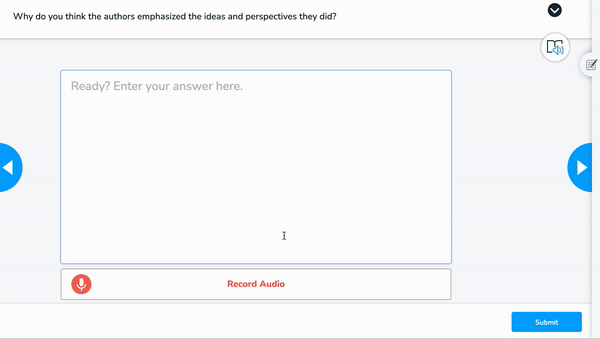
6 Strategies to provide meaningful student feedback
Student feedback is an invaluable tool that you as a teacher can use to not only enhance learning experiences but also improve teaching practices. Education is built on a foundation of strong relationships, and one of the most meaningful and fundamental is that between student and teacher. Student feedback—known as the student feedback cycle or feedback loop—is one way to gain valuable insights into your students’ perspectives, needs, and learning preferences. By actively seeking and listening to feedback from students, you can tailor your instruction to better meet student needs, identify areas for improvement, and foster a more engaging and inclusive learning environment.
What are the benefits of effective feedback for students?
Effective student feedback has far-reaching effects. From personalizing individuals’ learning to informing teachers’ methodology to fostering a positive school culture, a consistent and proactive feedback cycle can support the overall school community to reach its education goals. This feedback loop is most effective when it is grounded in authenticity and trust to promote students’ progress when it comes to their performance and behavior. MIT’s Teaching + Learning Lab states: “Effective feedback: 1) is targeted, 2) communicates progress, 3) is timely, and 4) gives students the opportunity to practice and implement the feedback received.”
What are the different types of feedback for students?
When providing feedback to students, you may find yourself doing so informally—by providing suggestions, recommendations, or course corrections in the moment. This informal feedback can become a meaningful exchange and provides the student with an opportunity to ask clarifying questions. Conversely, you may want to give more formal feedback at times in writing, through grades, or verbally. There are many video platforms that enable you to capture video or audio feedback to share a personalized message. This form of feedback tends to be more scheduled and tied to evidence of student progress against learning objectives and goals.
Additionally, feedback may be formative and provides guidance throughout the learning journey. This feedback may be more granular and helps students pivot, prevent missteps, and build confidence. Feedback may be summative and reflective of a task or the learning at the end of a unit. Summative feedback is benchmarked against learning objectives and usually looks back, as well as provides steps for moving forward and continuing to improve. As part of authentic assessments, many educators now use rubrics to help students provide feedback to one another or for themselves. Remember, the goal is for all types of feedback to be constructive.
Why use Nearpod to provide effective feedback?
Nearpod facilitates this seamless and continuous student feedback loop through high-quality instructional moments, engaging students in active learning experiences and guiding instruction decisions via real-time insights. Nearpod offers features to help provide support and scaffolding to students through instant visual and written feedback, helping to create a roadmap for both students and teachers to reach their learning objectives. With such feedback, Nearpod provides a solution that increases students’ participation, performance, and engagement by building their confidence, self-awareness, and enthusiasm for learning. Plus, the individual and collective data provides valuable insights to better inform your teaching methods and enhance classroom dynamics.
Foster a love of learning in every student with Nearpod. Teachers can sign up for free below to access and create interactive lessons. Administrators can schedule a call with an expert to unlock the full power of Nearpod for schools and districts.
6 Strategies to provide meaningful student feedback
1. Provide timely feedback
Why is feedback important to students? Nowadays, we don’t wait until the end of a unit to gather feedback. We recognize that the most meaningful feedback is immediate, just in time. A delay in feedback can result in the learner not connecting the feedback to the learning moment, thus deprioritizing the need for additional practice or learning; hence, there is no priority put on relearning or practicing the skill or concept. You want to help your students avoid cementing “bad habits” or misconceptions by intervening in the moment. Data-driven instruction relies on continuous formative assessment strategies; consider how these checks for understanding can be conveyed back to the student so that they can have agency in their own learning journeys.
With Nearpod’s real-time insights, you can see student responses in the moment and provide them immediate feedback verbally or with Live Teacher Feedback. Live Teacher Feedback is available in Draw It, Drag & Drop, and Math Manipulatives. Simply click on the “Give Feedback” button to expand the drawable toolbar. You can use Drawables to create stickers or annotations to praise, encourage, or provide support for students’ work. You can provide constructive feedback examples for students by pointing out real-world connections, providing contextualization, reteaching, or reemphasizing a key learning objective all within the student’s individual experience. Think of these types of student feedback as micro-interventions! Students will see your feedback in real time, and screenshots of all feedback will be saved into the related student post-session reports.
2. Consider words of motivation
While there are many types of student feedback, it needs to be authentic, inspiring, and empowering to motivate students to reach high and dream big. As you provide feedback for students, choose your words carefully to provide support that personalizes learning to individuals’ learning goals, whether that be a modification or a further challenge. Too often, ill-worded feedback can put a damper on students’ motivation, so seek out opportunities to praise student effort, work, and behavior (versus just course correcting) when it comes to the best way to provide feedback to students. How can your feedback be construed as constructive and not critical?
Within the Nearpod platform, you can share student work as exemplars. You can choose to do so anonymously and include or hide your feedback when you present student feedback examples. Showcasing student work is one way to bolster both extrinsic and intrinsic motivation, from garnering peer respect to building confidence. Provide positive feedback for students’ examples by sharing a “feedback sandwich” of COMPLIMENT, CORRECT, and COMPLIMENT.
3. Be action-oriented
In providing feedback for students, use data-informed practices to provide specifics about the next steps, rather than giving empty accolades. “Almost there!” or even “Well done!” doesn’t provide details on what the student achieved or what they may need to address. Targeted feedback includes actionable steps about what has been mastered or what needs to be improved upon. Lean on quantitative scores as well as qualitative responses to construct a robust profile of a student’s strengths and weaknesses. A continuous feedback cycle is not only beneficial to the student, but it also provides you the opportunity to make in-the-moment instructional decisions to better support your students’ needs.
Whether addressing the whole group, a small group, or individual students, such formal and informal checks for understanding can lead to best practices for data-driven schools. 86% of Nearpod’s customers say Nearpod helps evaluate student performance. Such data will encourage you to refine, redesign, and react in the most supportive manner. And this is where differentiation and personalization comes into play.
Nearpod offers nine types of formative assessment that teachers can weave into lesson plans to personalize students’ instruction and provide differentiation, which only increases student agency and ownership. Through your instructional design, you can provide micro-interventions by modifying existing lessons or assigning a variety of lessons, thereby tailoring instruction and making all learning experiences inclusive. You can choose interactive activities that promote gamification to help incentivize and motivate your students. Within your Teacher Dashboard, you can find individual and collective data about your classes’ interaction with Nearpod lessons and activities, whether teaching with Live or Student-Paced Lessons. Download and share these comprehensive reports as CSV or PDF files to guide your classroom’s next steps.
4. Take a co-constructed approach
True feedback should solicit a two-way conversation, a dialogue between student and teacher. Avoid just delivering (or, worse yet, lecturing), and instead seek out ways to involve your learners in evaluating progress. You can hold a mini-conference to analyze the results and consider the next steps. Take the opportunity to model how to assess and evaluate one’s own performance by asking questions. Scaffold examples of teacher feedback to students so that they will be active listeners. This approach will promote student agency and empowerment. It will highlight how learning is a partnership and collaboration between student and teacher. An ongoing feedback loop is a tried-and-true way to build rapport and foster trust within the classroom community.
Nearpod facilitates this type of co-constructed feedback experience. You can permit your students to access and assess their own reports to promote the creation of personal learning goals. By promoting accountability, you will encourage them to design a learning path aligned to their individual learning style(s). Imagine building this level of collaboration. You could even take it one step further and have students build metacognitive thinking skills by making Student Notes or creating a reflection via Audio Record on their progress, thus building an authentic portfolio of student work. No longer do teachers aspire to be “a sage on the stage” or conduct “a chalk and talk.” Instead, students are viewed as co-pilots. This simple shift in mindset makes for improved hands-on, minds-on engagement and simplifies classroom management.
Students need endless feedback more than they need endless teaching.
Grant Wiggins
5. Ask for continuous student feedback
Incorporating continuous student feedback into the classroom creates a more inclusive and responsive learning environment. By actively seeking student input, teachers can adapt their instructional strategies to better meet the needs of all learners. This process identifies areas where students may be struggling while also highlighting what is working well. Regular feedback loops encourage students to reflect on their own learning and communicate their needs, fostering a sense of agency and ownership over their educational journey. Implementing simple methods, such as exit tickets, quick surveys, or digital tools that allow for real time responses, ensures that student voices are heard consistently.
The Student Reactions feature was designed to empower students to actively participate in the feedback cycle. At any time during a Live Lesson, students can ask for help or respond to quick checks for understanding through a bank of visual icons. They might give a thumbs up to emphasize that they’re moving in the right direction, or they might choose a question mark to indicate that further clarification is needed. Student Reactions make it easier for educators to gauge student comprehension in real time. By encouraging this dynamic interaction, Nearpod ensures that every student has a voice, enhancing the overall learning experience while supporting more effective teaching strategies.
Additionally, Student Reactions boosts student accountability, driving them to take ownership of their learning progress. As students become more engaged and responsible for their own understanding, they are more likely to connect with the material and retain instructional content, leading to improved outcomes and a more enriching educational journey.
6. Let feedback guide your professional development
Encourage your administrator to analyze student data alongside you. Feedback patterns and trends should help structure what your school’s professional development could look like. In which areas are students struggling? Which instructional strategies could be improved? Too often, schools are data rich but insight poor. Schools need to adopt a data-driven mindset so that they are well informed, thorough, and strategic. Data-driven schools hold the promise of taking a more collaborative and community-based approach to school improvement. So, as a staff member, consider how you can help paint a more complete picture of your students wrapping the data in the empathy you bring into the classroom daily.
Nearpod’s platform offers content and interactive activities not just for students but for teachers as well. Your school can use the dynamic presentation tools to share professional development that teachers can tackle in person through a Group Presentation, or reference the content when needed within a school’s Library. Teaching teams can use Nearpod’s multimedia presentations to share data insights in a visually rich and digestive manner with one another. A school leader can introduce new resources or programs while providing interactive activities as instances of practice or quick checks for understanding with staff members as well. Additionally, a school leader can adopt these best practices when it comes to feedback in order to better support teachers’ needs as well.
Start using Nearpod for student feedback
In 21st-century learning, the 4Cs are critical: communication, collaboration, critical thinking, and creativity. These 4Cs are hallmarks of good feedback as well. The student feedback loop underscores the need for clear communication and meaningful collaboration. Students and teachers can use critical thinking to decipher what is working well in the classroom and which steps toward improvement may be needed. A feedback-rich classroom can ideate creatively to build a strong classroom culture that fosters positive, trusting, and respectful relationships. For more than a decade, Nearpod has been dedicated to embracing a similar mindset when it comes to receiving feedback from teachers and school leaders in its community. Designed by and for educators, Nearpod actively listens to product feedback to iterate on delivering standards-aligned content and innovative features that help teachers teach and students learn year after year. It’s really that simple!
Foster a love of learning in every student with Nearpod. Teachers can sign up for free below to access and create interactive lessons. Administrators can schedule a call with an expert to unlock the full power of Nearpod for schools and districts.

Darri Stephens is a dedicated LX (learning experience) designer, passionate about creating quality content and programs for kids, families, and educators. With MAs in Education from both Harvard and Stanford, and work experience at best-in-class ed tech organizations including Wonder Workshop, Nickelodeon, and Common Sense Education, she is steeped in the design thinking process and committed to agile and iterative project management, which has resulted in multi-award-winning programs and products.









